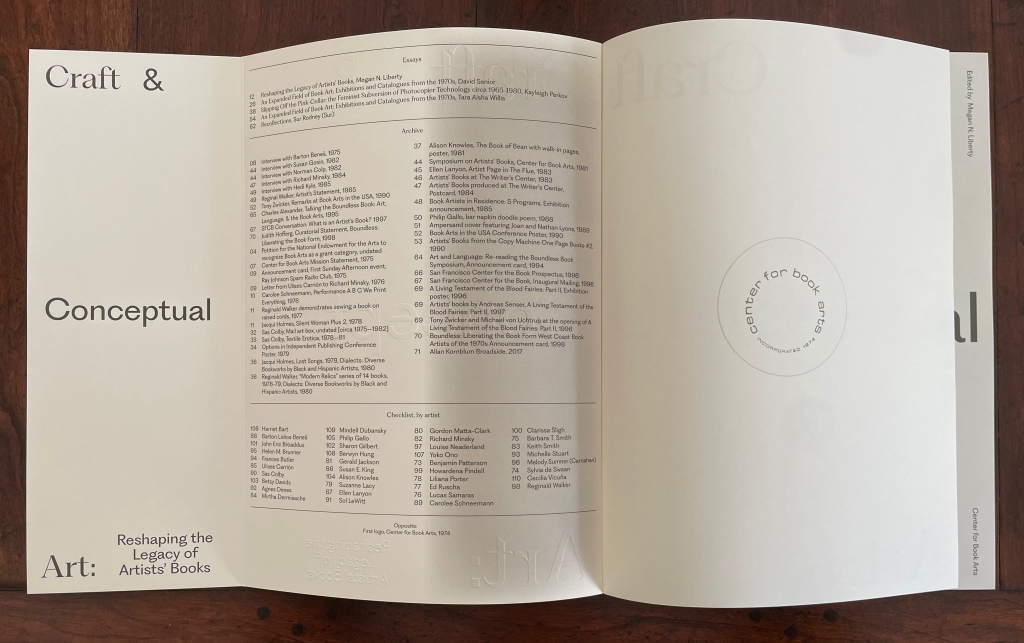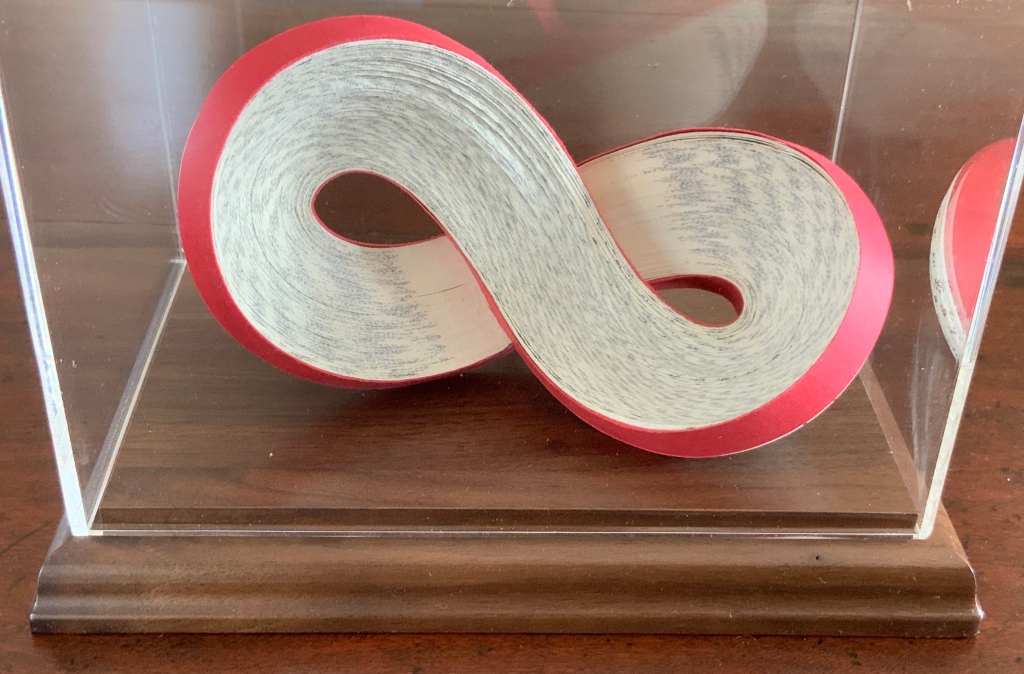Craft & Conceptual Art : Reshaping the Legacy of Artists’ Books (2023)

Craft and Conceptual Art: Reshaping the Legacy of Artists’ Books (2023)
Megan N. Liberty, ed.
Perfect bound, embossed and ink printed cover. H302 x W229 mm. 118 pages. Acquired from San Francisco Center for the Book (CODEX), 5 February 2024.
Photos: Books On Books Collection.
Megan Liberty’s traveling exhibition and catalogue serve two related purposes. The first is to present 40 archival items (interviews, invitations, announcements, letters, broadsides, photos, etc.) and over 3 dozen artworks from the last 30 years of the 20th century in a way that highlights the “collaboration and crossover” among several key institutions of the period: Philadelphia’s Moore College of Art; New York’s Center for Book Arts, Printed Matter and Franklin Furnace, Washington, DC’s The Writer’s Center, the Minnesota Center for Book Arts and the San Francisco Center for the Book. Their collaboration and crossover were often manifest in exhibitions, which are noted in Liberty’s introductory essay as well as David Senior’s contribution to the catalogue (“An Expanded Field of Book Art: Exhibitions and Catalogues from the 1970s”).

The second purpose is to make the argument that “craft and conceptual art mutually informed the evolution of artists’ books during the 1970s and 1980s”, which presents a more fluid view of the world of book art than is usually presented. The factions of the dematerialized and conceptual works, the democratic multiples, the limited editions and the unique finely or rawly crafted works were not so walled off from one another as implied in polemics, manifestos and critical essays so concerned with defining the “artist’s book”, the existence or placement of its apostrophe and securing its role in the larger history of art.
In touching on several exhibition catalogues, Liberty and Senior begin the work of mapping out an institutional history of artists’ books through exhibitions:
- Germano Celant’s Book as Artwork 1960/1972 (1972)
- Dianne Perry Vanderlip’s Artists Books (1973)
- Daniel Fendrick’s The Book as Art (1976)
- Manfred Schneckburger’s dOCUMENTA 6 (1977)
- Barbara London’s Bookworks (1977)
- Penelope Suess’ Women and the Printing Arts (1977)
- Jacki Apple’s Notebooks, Workbooks, Scripts, and Scores (1977)
- Judith Hoffberg and Joan Hugo’s Artwords and Bookworks (1978)
- Martha Wilson and Peter Frank’s Artists’ Books USA (1978)
- Rose Slivka’s Book Makers (1979)
- Horace Brockington’s Dialects: Diverse Bookworks by Black and Hispanic Artists (1980)
- Norman Colp’s Entrapped: The Book as Container (1981)
- Walker Art Center’s Artists’ Books Introduction (1981)
- Clive Phillpot’s Collaborations (1982)
- Norman Colp’s From Coast to Coast (1983)
- Center for Book Arts’ The First Decade (1984)
- Center for Book Arts’ Book Artists in Residence: 5 Programs (1985)
- Betty Bright’s Midwest Contemporary Book Art (1985)
- Steve Woodall’s Out West (1998)
Naturally the exhibition reflects many of the key themes, tools and techniques with which book artists were concerned during the period: the relationship between artists’ books and performance; the photocopier as an alternative printing tool; mail art; found art, collage and assemblage; feminism and the book as body; the AIDS epidemic; the passage of time and personal memory; racism in the art world; and mythology, religion and the mysticism of the book. Through these reflections, through attention to some of the period’s forgotten and less celebrated book artists, and through tracing the cross-fertilizations occurring across key institutions and their networks of individual artists and curators, Liberty revives Johanna Drucker’s definition of the artist’s book as a “zone of activity” where different disciplines, fields, and ideas intersect.
Alongside the exhibitions and catalogues it cites and those others it does not (see below), Craft and Conceptual Art stimulates a wishful longing for a blockbuster, truly international exhibition of book art and its history. Anna Sigrídur Arnar’s essay in On Curating (No. 33, June 2017) offers a model for contributions to it. Writing on the eve of dOCUMENTA 14 (2017), which was distinguished by the re-installation of Marta Minujín’s monumental 1983 The Parthenon of Banned Books (El Partenón de libros prohibitos), Arnar unearths documenta 5 (1972), documenta 6 (1977) and dOCUMENTA 13 (2012) as significant markers in the recognition and history of book art. As she notes, “it is actually documenta 5 where we first see a surprising number of artists producing and implementing books as a part of their practice”. If illustrated as well as Liberty’s and Arnar’s are, such an undertaking would rival the documenta 5 catalogue in size. Liberty’s exhibition and catalogue will find a place among its important predecessors and may be the spark for that larger more global institutional history of artists’ books through exhibitions.
Further Reading
“An Online Annotation of The Cutting Edge of Reading: Artists’ Books“. 7 September 2017. Bookmarking Book Art. Curators Renée Riese Hubert and Judd D. Hubert.
“An Online Annotation of Germano Celant’s Book as Artwork 1960/1972“. 9 October 2017. Bookmarking Book Art.
“Publishing as an Artistic Toolbox, Vienna, 28 January 2018“. 31 January 2018. Bookmarking Book Art.
“An Online Annotation of The Book Made Art (1986)“. 8 May 2020. Bookmarking Book Art. Curators Jeffrey Abt and Buzz Spector.
“Klaus Groh and Hermann Havekost“. 2 July 2021. Books On Books Collection. Curators of Artists’ Books / Künstlerbücher Buchobjekte / Livres d’Artistes / Libri Oggetti (1986).
Alden, Todd. 1991. The Library of Babel. Buffalo N.Y: Hallwalls Contemporary Arts Center.
Arnar, Anna Sigrídur. June 2017. “Books at documenta: Medium, Art Object, Cultural Symbol“. On Curating. 33. Accessed 17 February 2024.
Austin, Mary. 2012. Exploding the Codex : The Theater of the Book . San Francisco: San Francisco Center for the Book.
Barton, Carol and Diane Shaw. 1995. Science and the Artist’s Book. Smithsonian.
Bloch, Susi. 1973. The Book Stripped Bare : A Survey of Books by 20th Century Artists and Writers ; September 17 – October 21 1973. Hempstead, New York: Emily Lowe Gallery.
Drucker, Johanna. 2012. The Century of Artists’ Books. Rev. ed. New York City: Granary Books.
Henry, David J. 1986. Beyond Words: The Art of the Book. Rochester, N.Y. : Memorial Art Gallery of the University of Rochester
Hoptman, Laura J.; Robert Smithson and Dexter Sinister (Firm)2012. Ecstatic Alphabets. Berlin Germany New York N.Y: Sternberg Press ; Dexter Sinister.
Moeglin-Delcroix, Anne. 2011. Esthétique Du Livre D’artiste : 1960-1980 : Une Introduction À L’art Contemporain.Rev. ed. Paris: Bibliothèque nationale de France.
Phillpot, Clive. 1982. Artist’s Books : From the Traditional to the Avantgarde. New Brunswick NJ: Rutgers University Art Gallery.
Porter, Venetia. 2023. Artists Making Books : Poetry to Politics. London: British Museum Press.
Reed, Marcia, and Glenn Phillips. 2018. Artists and Their Books : Books and Their Artists. Los Angeles: Getty Research Institute.
Soltek, Stefan. 2013. Unbound. London and Offenbach-sur-le-Main: Arc Editions and Klingspor-Museum.
Vasiliunas, Kestutis. 1997. 1st International Artist‘s Book Triennial Vilnius 1997. Vilnius: Gallery “Kaire Desine”.
Vasiliunas, Kestutis. 2024. “10th International Artist’s Book Triennial Vilnius 2024“. Plunge, Lithuania: Plungė Municipal Clock Tower Library.























